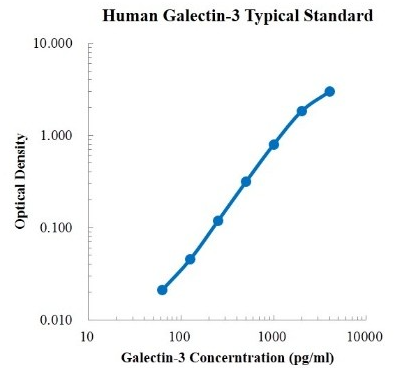Product Details
Product Details
Product Specification
| Description |
Detection Principle: This kit uses double antibody sandwich ELISA technology. The specific anti-human galectin-3 capture antibody was pre coated on a high affinity microplate. Add the standard, the sample to be tested and the biotin labeled detection antibody into the wells of the enzyme plate in turn, shake well and mix well, and then place it at room temperature for 2 hours of incubation process. Galectin-3 in the sample is combined with the solid-phase antibody and the detection antibody. After washing sufficiently to remove free and unbound components, streptavidin HRP (sa-hrp) labeled with horseradish peroxidase was added. After washing again, TMB chromogenic substrate was added and incubated at room temperature in the dark to develop color. The depth of color response is positively correlated with the concentration of galectin-3 in the sample. Add stop solution to stop the reaction, and use a microplate reader to measure the absorbance value at 450 nm detection wavelength (correction wavelength 570-630 nm). Detection Type: Double antibody sandwich method Form: pre coated 96 well plate Test Sample Type: cell supernatant, serum, plasma Loading Amount: 100 μ L Kit Components: A copy of pre coated 96 well plate, standard, galectin-3 detection antibody, standard dilution, detection buffer, TMB chromogenic substrate, washing solution, termination solution, sa-hrp, plate sealing membrane and instructions. Sensitivity: 2.46pg/ml Detection Range: 62.5-4000 pg/ml Recovery Range: 85-105% Storage Method: 2-8 ℃ Standard Curve:
Background: Galectin-3It belongs to the lectin family and is expressed in the nucleus, cytoplasm, mitochondria, cell surface and extracellular. Galectin-3 pair &beta-Galactosidase has affinity and exhibits its activity against bacteria and fungi. It is involved in many biological processes, such as cell adhesion, cell activation and chemotaxis, cell growth and differentiation, cell cycle and apoptosis. Based on its extensive biological functions, galectin-3 is considered to be related to cancer, inflammation and fibrosis, heart disease, stroke, etc. Galectin-3 expression levels are associated with various types of fibrosis. Galectin-3 expression is upregulated in liver fibrosis, kidney fibrosis, and idiopathic pulmonary fibrosis (IPF). In acute decompensated heart failure and chronic heart failure populations, high expression of galectin-3 leads to a higher risk of death. Meanwhile, galectin-3 is thought to play an important role in tumor metastasis. |



